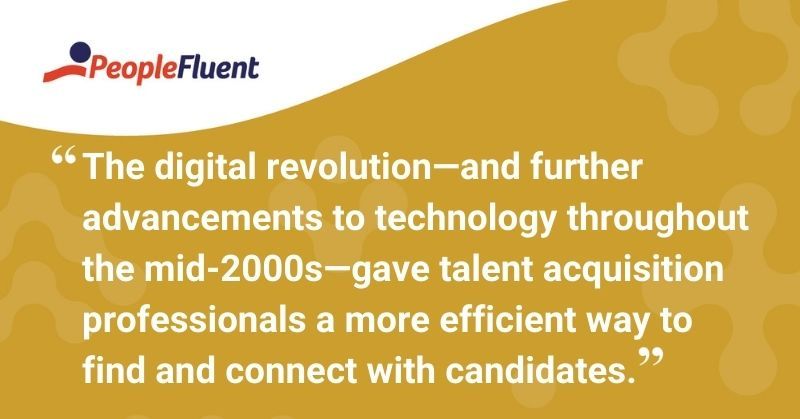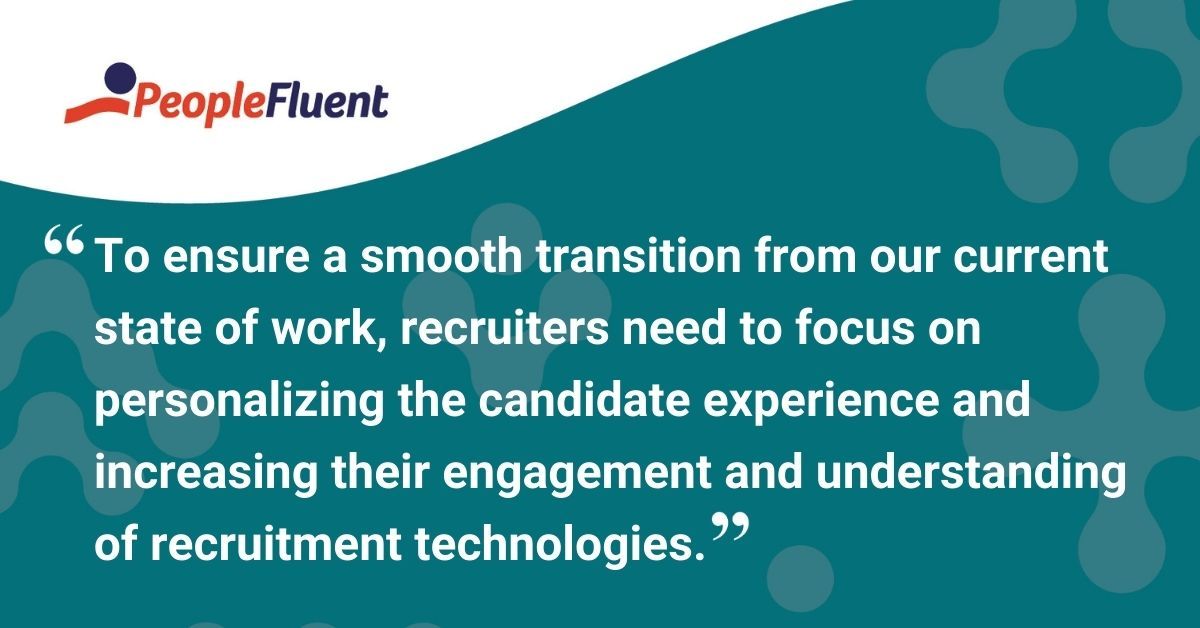Published: Sep 28, 2020Time to read: 6mins Category: Insights
The Evolution of Recruiting: From the Digital Revolution to a More Human Approach
Table of Contents
Adapting to sudden workplace shifts has long been a constant for business leaders. Whether the previous shifts were caused by disruptive technology or other market forces, they created a call to action for leaders across almost every business function. In this article, we’ll take a deep dive into how the practice of recruiting has evolved over the 21st century. We also consider how HR professionals can overcome challenges by leveraging best practices in recruiting—in today’s climate and beyond.
Although constant change has been defining expectations in nearly every organization, recruiters have remained true to their mission. Even as they face new obstacles due to the way their roles have shifted. The phenomenon of recruiters favoring cheerful invitations when interacting with job seekers using the #opentowork hashtag on LinkedIn is just one example of an emerging shift to a more genuine, human approach.
Time and again, recruiters show up with enthusiasm and a commitment to creating efficient processes that enhance the candidate experience and drive value for their respective organizations. They are increasingly interested in utilizing recruitment software to support their day-to-day processes. This makes it easier to focus on fostering human connections—especially during this period of remote work.
Risk-averse HR leaders may have lingering questions about the future of recruiting, though. One question that we’re keen to examine in this article is: Will these trends continue after we return to a ‘new normal’? While none of us can say for certain what the future holds, it’s important to start by looking at how the recruiting industry responded to similar challenges in the past.
Recommended reading to download: ‘PeopleFluent Recruiting Product Sheet’
How Has Recruiting Evolved in the 21st Century?
When examining some of the changes to 21st century recruiting trends, it’s a relatively uneventful timeline until the second decade, which saw shrinking talent pools due to data-handling regulations implemented by the EU’s GDPR. In fact, one of the only notable changes to take place in the early 2000s was a shift from fax to email as a means for recruiters to receive an applicant’s resume.
However, the digital revolution—and further advancements to technology throughout the mid-2000s—gave talent acquisition professionals a more efficient way to find and connect with candidates. Interestingly enough, this tech boom coincided with the global financial crisis of 2008 which resulted in millions being unemployed and job seekers flooding the market.
These seismic forces ultimately gave way to key disruptions in the recruiting industry, such as:
- Contingent and/or freelance work becoming more prevalent
- Changes to—and the automation of—hiring workflows
- Data integrations and real-time feedback
- The ability to apply to positions while being mobile and using stored documents
- Voluntary separations/quit-rates rising year-over-year

More from the blog: ‘Increase Hiring Efficiency With These 4 Best Practices’
Cycling Between Candidate and Employer Markets
The historic peak in unemployment rates reached 9.9% at the end of 2009, up nearly 5% from the previous year, resulting in a shift from the candidate-led market to one that benefited employers.
After global markets began stabilizing in 2010, US job postings grew by 88% that year, a welcome rebound after the 13% decline in 2009. While some organizations remained uncertain about thawing their hiring freeze after the recession, forward-thinking companies were committed to optimizing recruitment practices. This proactive approach helped prepare recruiters for high-volume recruiting and the changing candidate behaviors—ultimately allowing them to remain competitive, even as staffing agencies began to automate sourcing.
Eight years following the recession’s end, the market had become candidate-led once more as unemployment rates continued falling, finally settling just under 4% in the summer of 2018. During this time, recruitment marketing gained steam in response to job seekers changing the way they look for work—specifically their inclination to use keywords via search engines rather than sifting through job boards. This practice gave way to AI in the recruiting industry as it provided talent acquisition professionals with more efficient methods for sourcing and recruiting top candidates.
You might also like: ‘Hiring From Within: How To Create a Culture of Internal Mobility’
The Evolution Isn’t Over: Focusing on the Human Element of Recruitment
With global unemployment rates in flux throughout most of 2020, organizations are now scrambling to retain top talent and reskill existing employees for other opportunities in the business. The back and forth we’ve seen over the past two decades has been a disruptor for sure, but it’s also provided savvy recruitment professionals with an opportunity to fine-tune their digital recruiting strategies by adapting to technology.
In recent months, job seekers have taken to social networking sites like LinkedIn to share their stories of being furloughed or laid off during the COVID-19 pandemic. A refreshing wave of recruiters, hiring managers, and other HR professionals have responded to these stories in kind, sometimes offering strangers a free resume review or connecting them with viable employment opportunities.

Related reading: ‘How COVID-19 Has and Will Change Recruiting Strategies’
Examining how recruiters managed to overcome challenges caused by the recession of 2008 may provide some organizations with a semblance of hope, but conservative organizations are right to be cautious—especially with many variables at play. Certainly, we should praise risk-averse companies for providing existing employees with a sense of security while also protecting the organization’s interests.
Nonetheless, now is the time for HR leaders to encourage recruiters and hiring managers to continue making genuine human connections with job seekers. This represents a critical element that’s been missing from the industry for decades.
To ensure a smooth transition from our current state of work (whenever that might be), it’s imperative for recruiters to focus on the following:
- Personalizing the candidate experience with a human approach
- Increasing their engagement and understanding of recruitment technologies
- Utilizing video conferencing tools and automated, but personalized, communications
- Creating a recruitment marketing strategy
- Developing a strong employer brand
- Developing a talent mobility plan that provides customized career development
To learn more about the current best practices, and how recruiters can drive value for organizations, watch this on-demand recording of the PeopleFluent webinar, ‘Recruitment Workflow Best Practices: From the Simple to the Complex’.
Discover How Recruitment Lets You Find the Right People—Fast
PeopleFluent helps you fill critical roles with the right people and the right skillsets on a global scale. At the same time, it helps you build your employer brand and sharpen your competitive edge.